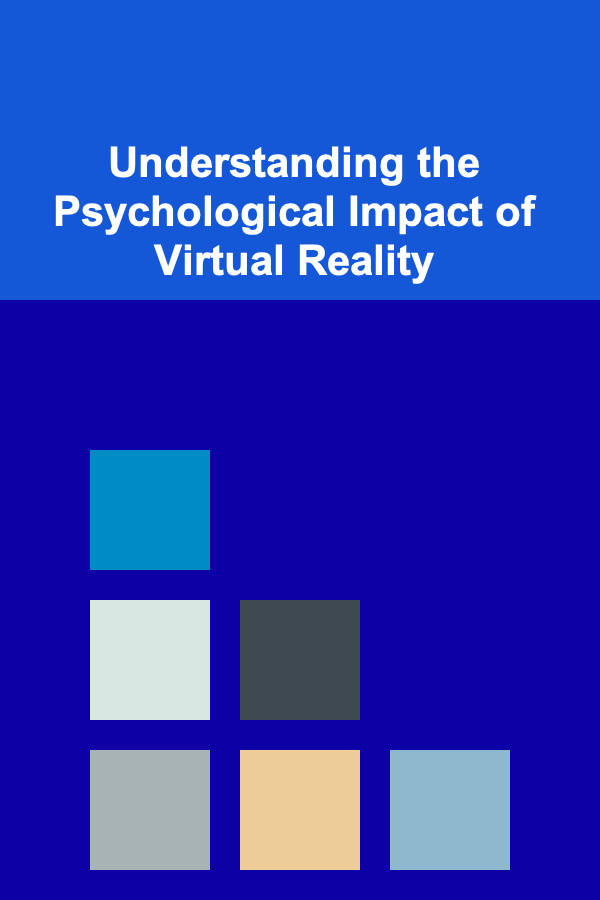
Understanding the Psychological Impact of Virtual Reality
ebook include PDF & Audio bundle (Micro Guide)
$12.99$11.99
Limited Time Offer! Order within the next:

Virtual Reality (VR) technology has rapidly evolved from a science fiction fantasy to a tangible and increasingly accessible reality. Beyond its applications in entertainment and gaming, VR is finding its way into fields like education, healthcare, training, and even therapy. This technological advancement, however, brings with it a complex array of psychological impacts, both positive and negative. Understanding these impacts is crucial for responsible development, ethical implementation, and maximizing the benefits of VR while mitigating potential risks.
The Illusion of Presence and Embodiment
At the heart of VR's psychological influence lies the concept of presence. Presence is the subjective feeling of "being there" within the virtual environment. It's not simply about seeing the virtual world, but about believing that you are actually present in that world. Several factors contribute to presence, including:
- Immersion: The technical capabilities of the VR system to block out external stimuli and replace them with virtual ones. Higher resolution displays, wide field of view, and low latency contribute to greater immersion.
- Sensory Fidelity: The realism of the sensory information provided by the VR system. This includes visual fidelity (realistic graphics), auditory fidelity (spatial audio), and haptic feedback (sense of touch).
- Interaction Fidelity: The degree to which the user can interact with the virtual environment in a natural and intuitive way. This includes realistic physics, responsive controls, and the ability to manipulate virtual objects.
Higher levels of presence correlate with stronger psychological effects. When individuals genuinely believe they are in the virtual world, they tend to react emotionally and behaviorally as they would in a similar real-world situation. This opens up exciting possibilities for training and therapy, but also raises concerns about potential psychological harm.
Closely related to presence is the concept of embodiment, which refers to the feeling of having a body within the virtual environment. VR can allow users to inhabit different bodies, changing their perceived gender, race, age, or even species. This can have profound effects on self-perception, empathy, and social behavior. For example, studies have shown that embodying an elderly avatar can increase empathy for the elderly, while embodying a different race can reduce implicit racial bias. However, the psychological effects of inhabiting drastically different bodies are still being investigated and require careful consideration.
Positive Psychological Impacts of VR
When designed and implemented effectively, VR can offer a range of significant psychological benefits:
Exposure Therapy and Anxiety Reduction
VR is proving to be a powerful tool for exposure therapy, a form of cognitive behavioral therapy used to treat anxiety disorders. By creating safe and controlled virtual environments that simulate real-world triggers, VR allows individuals to gradually confront their fears and anxieties without the risks associated with real-world exposure. This has shown promise in treating phobias (e.g., fear of heights, fear of public speaking), post-traumatic stress disorder (PTSD), and social anxiety. The controlled nature of VR allows therapists to precisely tailor the exposure experience to the individual's needs, gradually increasing the intensity and complexity of the situation as the individual becomes more comfortable. The sense of presence within the VR environment ensures that the exposure feels real enough to elicit an emotional response, facilitating the therapeutic process.
Pain Management
VR can be used as a non-pharmacological approach to pain management. Distraction is a well-established pain management technique, and VR provides a highly immersive and engaging form of distraction. By focusing their attention on the virtual environment, individuals can reduce their awareness of pain. VR can also be used to teach relaxation techniques and provide guided imagery, further contributing to pain relief. Studies have shown that VR can be effective in reducing pain associated with burns, chronic pain conditions, and medical procedures. For example, patients undergoing painful wound care procedures have reported significant reductions in pain when using VR during the procedure.
Skill Training and Cognitive Enhancement
VR offers a safe and cost-effective environment for practicing complex skills. Whether it's surgical training, flight simulation, or public speaking, VR allows individuals to repeatedly practice skills without the risks and costs associated with real-world training. The realistic simulations provide valuable feedback, allowing individuals to identify and correct errors in a safe and controlled environment. Furthermore, VR can be used to enhance cognitive skills such as memory, attention, and problem-solving. Specifically designed VR games and simulations can challenge individuals in specific cognitive domains, leading to improvements in performance. For example, VR programs designed to improve spatial reasoning skills can be used to rehabilitate stroke patients or enhance the performance of architects and engineers.
Empathy and Perspective-Taking
As mentioned earlier, VR allows individuals to embody different avatars and experience the world from different perspectives. This can be a powerful tool for fostering empathy and reducing prejudice. By experiencing the world through the eyes of someone from a different race, gender, or socioeconomic background, individuals can gain a deeper understanding of their experiences and challenges. VR simulations can also be used to promote empathy for individuals with disabilities or mental health conditions. For example, a VR simulation that mimics the symptoms of schizophrenia can help individuals better understand the challenges faced by people with this condition. This has potential implications for improving social interactions, reducing discrimination, and promoting social justice.
Motivation and Rehabilitation
VR can be highly motivating and engaging, making it a valuable tool for rehabilitation. For patients recovering from stroke or other neurological conditions, VR can provide a fun and challenging environment for practicing motor skills and cognitive functions. The interactive nature of VR can make rehabilitation more enjoyable and engaging, leading to increased motivation and adherence to therapy. VR can also be used to create personalized rehabilitation programs that are tailored to the individual's specific needs and goals. The ability to track progress and provide feedback in real-time can further enhance motivation and accelerate the recovery process.
Negative Psychological Impacts of VR
Despite its potential benefits, VR also carries several potential psychological risks that need to be carefully considered:
Cybersickness
Cybersickness is a common side effect of VR use, characterized by symptoms similar to motion sickness, such as nausea, dizziness, disorientation, and headache. It occurs when there is a mismatch between the visual information received by the eyes and the vestibular information received by the inner ear. For example, if the user is visually experiencing movement in the virtual environment but is physically stationary, this can trigger cybersickness. The severity of cybersickness varies depending on the individual, the VR system, and the content being viewed. Factors that can contribute to cybersickness include low frame rates, high latency, and a wide field of view. Strategies for mitigating cybersickness include using VR systems with high frame rates and low latency, taking frequent breaks, and avoiding content that involves rapid or jerky movements. Researchers are also exploring the use of habituation techniques to help individuals adapt to VR and reduce their susceptibility to cybersickness.
Disorientation and Spatial Discomfort
Prolonged VR use can lead to disorientation and spatial discomfort, particularly in environments that are visually complex or disorienting. The lack of physical cues and the artificial nature of the virtual environment can make it difficult for individuals to maintain a sense of spatial awareness. This can lead to feelings of confusion, disorientation, and even anxiety. It's important to design VR environments that are intuitive and easy to navigate, and to provide users with clear visual cues to help them maintain their sense of spatial orientation. Techniques such as "teleportation" (instantaneously moving from one location to another) can also contribute to disorientation and should be used sparingly. Furthermore, individuals with pre-existing vestibular disorders may be more susceptible to disorientation and spatial discomfort in VR.
Reality Blurring and Detachment
The immersive nature of VR can sometimes lead to a blurring of the lines between reality and virtuality. Prolonged exposure to VR may cause individuals to experience difficulty distinguishing between real and virtual experiences, leading to feelings of detachment from the real world. This is particularly concerning for individuals who are already prone to dissociation or have a history of mental health problems. It's important to encourage users to maintain a strong connection with the real world and to avoid using VR as an escape from real-life problems. Furthermore, the content of VR experiences can also influence the degree of reality blurring. Highly realistic and emotionally intense VR experiences may be more likely to lead to reality blurring than more abstract or less engaging experiences. Researchers are actively investigating the long-term effects of VR on reality perception and are developing strategies to mitigate the potential risks.
Addiction and Excessive Use
Like any addictive technology, VR has the potential for excessive use and addiction. The immersive and engaging nature of VR can make it highly appealing, and individuals may spend excessive amounts of time in virtual environments, neglecting their real-life responsibilities. This can lead to social isolation, financial problems, and physical health problems. It's important to promote responsible VR use and to encourage users to maintain a healthy balance between their virtual and real lives. Setting time limits for VR use, taking frequent breaks, and engaging in other activities outside of VR can help prevent addiction. Furthermore, it's important to be aware of the potential signs of VR addiction, such as spending increasing amounts of time in VR, neglecting real-life responsibilities, and experiencing withdrawal symptoms when not using VR. Individuals who are struggling with VR addiction may benefit from professional help.
Psychological Trauma and Triggering Content
VR has the potential to trigger psychological trauma, particularly if the virtual environment contains content that is reminiscent of past traumatic experiences. For example, a VR simulation of a car accident could trigger PTSD symptoms in someone who has been involved in a car accident. It's crucial to carefully screen VR content for potentially triggering material and to provide users with warnings before exposing them to such content. Furthermore, individuals with a history of trauma should be particularly cautious when using VR and should seek guidance from a mental health professional. In some cases, VR can be used as a tool for processing trauma, but this should only be done under the supervision of a trained therapist. The use of VR in trauma therapy requires careful assessment, planning, and monitoring to ensure that the experience is therapeutic and not retraumatizing.
Ethical Concerns and Data Privacy
The use of VR raises several ethical concerns, particularly regarding data privacy. VR systems can collect a wealth of personal data about users, including their gaze direction, head movements, and physiological responses. This data can be used to infer sensitive information about their thoughts, emotions, and behaviors. It's crucial to protect the privacy of VR users and to ensure that their data is not used for purposes they did not consent to. Furthermore, the immersive nature of VR raises concerns about manipulation and coercion. VR environments can be designed to influence users' thoughts and behaviors in subtle and unconscious ways. It's important to be aware of these potential risks and to develop ethical guidelines for the design and use of VR technology. Transparency, informed consent, and user control are essential principles for ensuring the ethical use of VR.
Mitigating the Risks and Maximizing the Benefits
Understanding the psychological impact of VR is only the first step. To maximize the benefits and minimize the risks, several strategies are necessary:
- Careful Content Design: VR content should be designed with psychological well-being in mind. This includes avoiding potentially triggering material, minimizing disorienting effects, and promoting positive emotions and behaviors.
- User Education and Training: Users should be educated about the potential risks and benefits of VR and provided with training on how to use VR systems safely and responsibly.
- Monitoring and Feedback: VR systems should be designed to monitor users' physiological and psychological responses and provide feedback to help them manage their experience.
- Ethical Guidelines and Regulations: Clear ethical guidelines and regulations are needed to govern the development and use of VR technology.
- Ongoing Research: Continued research is essential to better understand the long-term psychological effects of VR and to develop strategies for mitigating potential risks.
The Future of VR and Psychology
VR is still a relatively new technology, and its psychological impact is still being explored. As VR technology continues to evolve and become more accessible, it's likely that its psychological impact will become even more significant. Future research will need to focus on several key areas, including:
- The Long-Term Effects of VR Use: Little is known about the long-term psychological effects of prolonged VR use. Longitudinal studies are needed to track the psychological health of VR users over time.
- The Effects of Different Types of VR Content: Different types of VR content may have different psychological effects. Research is needed to identify the types of content that are most likely to be beneficial or harmful.
- The Impact of VR on Specific Populations: Different populations may be more or less susceptible to the psychological effects of VR. Research is needed to understand the impact of VR on children, adolescents, the elderly, and individuals with mental health problems.
- The Development of New VR Therapies: VR has the potential to be a powerful tool for treating a wide range of mental health conditions. Research is needed to develop and evaluate new VR therapies.
In conclusion, understanding the psychological impact of VR is crucial for responsible development, ethical implementation, and maximizing the benefits of this transformative technology. By carefully considering the potential risks and benefits, we can harness the power of VR to improve mental health, enhance learning, and promote social good.

How to Stage Your Home for Different Buyer Demographics
Read More
The IT Director's Guide: Leading Technology Teams and Driving Innovation
Read More
Mastering the Art of French Braiding: A Comprehensive Guide
Read More
Creating a Strong Company Culture for Your Small Business
Read More
How to Make Wine from Wild Berries
Read More
10 Tips for a Budget-Friendly Event Planning Checklist
Read MoreOther Products

How to Stage Your Home for Different Buyer Demographics
Read More
The IT Director's Guide: Leading Technology Teams and Driving Innovation
Read More
Mastering the Art of French Braiding: A Comprehensive Guide
Read More
Creating a Strong Company Culture for Your Small Business
Read More
How to Make Wine from Wild Berries
Read More